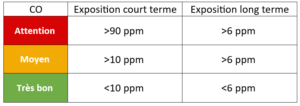Controlling and automating buildings for energy efficiency
Presence control and building automation are key elements of energy efficiency. By intelligently monitoring and regulating energy consumption, you can reduce your carbon footprint while making considerable savings. Our innovative technologies make it easier to monitor actual occupancy rates in your buildings, so you can implement systems that optimize energy use and provide better service for your employees.

Frequently Asked Questions
Our experts answer your questions
In an enclosed space, heat rises and stagnates at the ceiling, where the temperature is de facto a little higher than in the rest of the room. To ensure correct measurement of ambient temperature, we recommend mounting the detector on a wall 50 cm below the ceiling.
Our detectors are certified by the LNE (Laboratoire National de Métrologie et d’Essais), giving them a high level of safety and performance. Factory-tested, our products are compatible with regulatory devices.
Moisture comes from a variety of sources, including human activity, breathing and architectural design problems. Air that’s too dry dries out the respiratory tract, and humidity that’s too high promotes allergies. Ideally, the humidity level in an enclosed space should be between 40% and 60%.
VOCs have very harmful effects on health. These molecules can trigger heart and nervous system disorders, irritation of the eyes and mucous membranes of the respiratory tract, nausea and more.
VOCs are detectable in :
- Furniture (tables, cupboards, etc.), wall and ceiling coverings
- Consumer products (cleaning and synthesis agents, solvents, degreasers, etc.)
- Finishing products (varnish, glue, acrylic, silicone, etc.).
It is therefore important to be able to differentiate Volatile Organic Compounds from the rest of the pollutants present in the air.
NEXELEC Volatile Organic Compounds sensors continuously analyze the air and detect VOCs to help you act accordingly.
NEXELEC sensors are capable of measuring different pollutants, depending on the model. Depending on the country and the environment, thresholds may vary.
Depending on WHO and ANSES regulations, thresholds may differ from one country to another.
The values set out below are valid for ERP (Etablissements Recevant du Public) in France.
Carbon Dioxide (CO2)
CO2 is a good indicator of Indoor Air Quality. If ppm levels are too high, ventilate as soon as possible.
Volatile organic compounds (VOCs)
These compounds are emitted by paints, glues and other solvents. If the concentration is too high, ventilate as soon as possible.
Fine Particles (PM)
PM are grouped into 3 categories: PM1, PM2.5 and PM10
Fine particles are often found in dust and smoke. Prolonged exposure presents a health risk. When the threshold is too high, open the windows to renew the indoor air.
Formaldehyde (HCHO)
Formaldehyde can be found in new furniture, cleaning products and so on. If your detector emits a Red LED, take action as soon as possible.
Carbon monoxide (CO)
If carbon monoxide levels reach excessive levels in a room, it presents a potentially fatal hazard. It’s crucial to detect the origins of CO in the environment, and to have all combustion appliances inspected, such as stoves, boilers, stoves and so on. If the threshold is too high, ventilate the room as much as possible.
1,000+ customers
Local authorities, landlords, and businesses




















